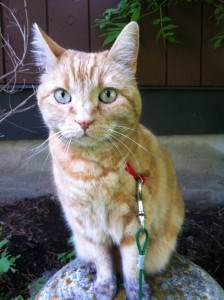
I got our cat Oscar from the SPCA in Whitehorse, Yukon. When I picked him out his name was “Jerry” and he was being mauled by girl guides. Clearly, someone had to put a stop to it. At least that’s what I told myself. My husband, Geoff, will tell you I grabbed him in a hormone-induced blackout caused by a early-thirties-internal-clock-need to cuddle something small.
He may have been partly (almost entirely) right, because while acting on this strong instinct, I did very little to prepare for our life with a cat. Growing up I had a lovely lady cat who lived for 23 years. She was polite and cuddly, didn’t scratch stuff and ate only what she needed. We let her out. She did cat things. She came back. Cats, I had learned, were a wonderful, independent companion.
I quickly realized that Oscar was different. He had no apparent off-switch when it came to eating. We had to install child locks on all of our kitchen cupboards so that he didn’t maim bags of dried apricots and ingest latex gloves. He scratched things, including me. Sometimes he bit me when he was mad. On top of all that, under Whitehorse bylaws, he was required to wear a leash.
Leash Oscar? What about burning off all his male cat energy? What about letting a cat be a cat? What were these municipal bureaucrats thinking?
I guess they had their reasons. I’m sure a few suburban wars have started over cats pooing in neighbours’ vegetable gardens. I know one of my friends has several small, hard brown reasons to dislike cats, as illustrated in this conversation:
Me: “Nice Garden.”
Her: “Thanks.”
Me: “Is that a potato you just dug up?”
Her: “No, it’s cat poo.”
I think the City of Whitehorse may have been seeking to avoid these types of neighbourly conflicts, which is probably a good idea. No one likes it when your cat spritzes anal gland juice on their screen door.
Hence, Oscar became one of the few law-abiding cats in Whitehorse. When we moved down to Jasper, and into our townhouse with common lawns, his on-leash journey continued.
It’s really not just about neighbours. It shouldn’t be news to anyone that cats are methodical killing machines. In 2013 a study estimated cats are killing more than one billion birds each year. That’s a lot. Sure, a lot of the cats doing the killing are of the feral variety, but cared for cats (AKA subsidized predators) do plenty of damage.
It’s not like Oscar is harmless on his leash. To fully observe the fear a domestic cat can instill in a neighbourhood, one need only try to walk a dog near Oscar’s “circle of death*” outside our front door. His leash gives him a roughly four-metre diameter territory, and fidos who come too close get a good face lashing. Once in a while he slays small mammals despite being harnessed to a stake - mice and voles that apparently can’t smell the flower-bed turned litter box along the side of our house. On the one hand I feel bad about this, but on the other, there’s something Darwinian at play, n’est-ce pas? I mean, sometimes I can smell the urine from my kitchen.
So that’s why we do it. We don’t want him bothering people, and we don’t want him killing things. I’m sure Oscar would argue that a few daily rounds of tape-ball fetch doesn’t make up for a lifetime of missed roaming and back alley tussles. To that I say: “Oscar, I feed you $60-a-month hypoallergenic cat food every day - food that you don’t have to hunt down yourself, and that you won’t barf up from your sensitive stomach. We immunize you, de-worm you and brush sap out of your fur. You are a loved and pampered predator. Life isn’t so bad.”
* “Circle of death” was a phrase coined by the lovely veterinarian Dr. Emily Jenkins, while talking about leashed cats over bacon and coffee at the Banff Centre.
Niki Wilson
Special to the Fitzhugh
